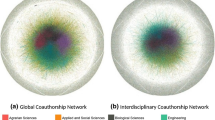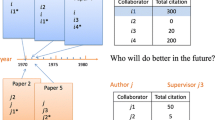Abstract
Scientists may encounter many collaborators of different academic ages throughout their careers. Thus, they are required to make essential decisions to commence or end a creative partnership. This process can be influenced by strategic motivations because young scholars are pursuers while senior scholars are normally attractors during new collaborative opportunities. While previous works have mainly focused on cross-sectional collaboration patterns, this work investigates scientific collaboration networks from scholars’ local perspectives based on their academic ages. We aim to harness the power of big scholarly data to investigate scholars’ academic-age-aware collaboration patterns. From more than 621,493 scholars and 2,646,941 collaboration records in Physics and Computer Science, we discover several interesting academic-age-aware behaviors. First, in a given time period, the academic age distribution follows the long-tail distribution, where more than 80% scholars are of young age. Second, with the increasing of academic age, the degree centrality of scholars goes up accordingly, which means that senior scholars tend to have more collaborators. Third, based on the collaboration frequency and distribution between scholars of different academic ages, we observe an obvious homophily phenomenon in scientific collaborations. Fourth, the scientific collaboration triads are mostly consisted with beginning scholars. Furthermore, the differences in collaboration patterns between these two fields in terms of academic age are discussed.













Similar content being viewed by others
References
Badar, K., Frantz, T. L., & Jabeen, M. (2016). Research performance and degree centrality in co-authorship networks: The moderating role of homophily. Aslib Journal of Information Management, 68(6), 756–771.
Badar, K., Hite, J. M., & Ashraf, N. (2015). Knowledge network centrality, formal rank and research performance: Evidence for curvilinear and interaction effects. Scientometrics, 105(3), 1553–1576.
Badar, K., Hite, M. J., & Badir, F. Y. (2014). The moderating roles of academic age and institutional sector on the relationship between co-authorship network centrality and academic research performance. Aslib Journal of Information Management, 66(1), 38–53.
Barabási, A.-L. (2016). Network science. Cambridge: Cambridge University Press.
Borrett, S. R., Moody, J., & Edelmann, A. (2014). The rise of network ecology: Maps of the topic diversity and scientific collaboration. Ecological Modelling, 293, 111–127.
Çavuşoğlu, A., & Türker, İ. (2014). Patterns of collaboration in four scientific disciplines of the turkish collaboration network. Physica A: Statistical Mechanics and its Applications, 413, 220–229.
Dong, Y., Yang, Y., Tang, J., Yang, Y., & Chawla, N. V. (2014). Inferring user demographics and social strategies in mobile social networks. In Proceedings of the 20th ACM SIGKDD international conference on Knowledge discovery and data mining (pp. 15–24). ACM.
Ferreira, A. A., Gonçalves, M. A., & Laender, A. H. (2012). A brief survey of automatic methods for author name disambiguation. Acm Sigmod Record, 41(2), 15–26.
Granovetter, M. (1985). Economic action and social structure: The problem of embeddedness. American Journal of Sociology, 91(3), 481–510.
Guimera, R., Uzzi, B., Spiro, J., & Amaral, L. A. N. (2005). Team assembly mechanisms determine collaboration network structure and team performance. Science, 308(5722), 697–702.
Katz, J. S., & Martin, B. R. (1997). What is research collaboration? Research Policy, 26(1), 1–18.
Ke, Q., & Ahn, Y.-Y. (2014). Tie strength distribution in scientific collaboration networks. Physical Review E, 90(3), 032804.
King, M. M., Bergstrom, C. T., Correll, S. J., Jacquet, J. & West, J. D. (2016). Men set their own cites high: Gender and self-citation across fields and over time. arXiv preprint arXiv:1607.00376.
Kong, X., Jiang, H., Yang, Z., Xu, Z., Xia, F., & Tolba, A. (2016). Exploiting publication contents and collaboration networks for collaborator recommendation. PloS ONE, 11(2), e0148492.
Lazarsfeld, P. F., Merton, R. K., et al. (1954). Friendship as a social process: A substantive and methodological analysis. Freedom and Control in Modern Society, 18(1), 18–66.
Lee, S., & Bozeman, B. (2005). The impact of research collaboration on scientific productivity. Social Studies of Science, 35(5), 673–702.
Leskovec, J., Backstrom, L., Kumar, R., & Tomkins, A. (2008). Microscopic evolution of social networks. In Proceedings of the 14th ACM SIGKDD international conference on Knowledge discovery and data mining (pp. 462–470). ACM.
Ley, M. (2009). Dblp: Some lessons learned. Proceedings of the VLDB Endowment, 2(2), 1493–1500.
Lou, T., Tang, J., Hopcroft, J., Fang, Z., & Ding, X. (2013). Learning to predict reciprocity and triadic closure in social networks. TKDD, 7(2), 5.
Milojević, S. (2014). Principles of scientific research team formation and evolution. Proceedings of the National Academy of Sciences, 111(11), 3984–3989.
Newman, M. E. (2001a). Clustering and preferential attachment in growing networks. Physical Review E, 64(2), 025102.
Newman, M. E. (2001b). Scientific collaboration networks. I. Network construction and fundamental results. Physical Review E, 64(1), 016131.
Newman, M. E. (2001c). The structure of scientific collaboration networks. Proceedings of the National Academy of Sciences, 98(2), 404–409.
Newman, M. E. (2004). Coauthorship networks and patterns of scientific collaboration. Proceedings of the National Academy of Sciences, 101(suppl 1), 5200–5205.
Opsahl, T., Agneessens, F., & Skvoretz, J. (2010). Node centrality in weighted networks: Generalizing degree and shortest paths. Social Networks, 32(3), 245–251.
Ortega, J. L. (2014). Influence of co-authorship networks in the research impact: Ego network analyses from microsoft academic search. Journal of Informetrics, 8(3), 728–737.
Petersen, A. M. (2015). Quantifying the impact of weak, strong, and super ties in scientific careers. Proceedings of the National Academy of Sciences, 112(34), E4671–E4680.
Petersen, A. M., Fortunato, S., Pan, R. K., Kaski, K., Penner, O., Rungi, A., et al. (2014). Reputation and impact in academic careers. Proceedings of the National Academy of Sciences, 111(43), 15316–15321.
Schult, D. A., & Swart, P. (2008). Exploring network structure, dynamics, and function using networkx. In Proceedings of the 7th python in science conferences (SciPy 2008) (Vol. 2008, pp. 11–16).
Sinatra, R., Wang, D., Deville, P., Song, C., & Barabási, A.-L. (2016). Quantifying the evolution of individual scientific impact. Science, 354(6312), aaf5239.
Sinha, A., Shen, Z., Song, Y., Ma, H., Eide, D., Hsu, B.-J. P., & Wang, K. (2015). An overview of microsoft academic service (mas) and applications. In Proceedings of the 24th international conference on World Wide Web (pp. 243–246). ACM.
Sugimoto, C. R., Sugimoto, T. J., Tsou, A., Milojević, S., & Larivière, V. (2016). Age stratification and cohort effects in scholarly communication: A study of social sciences. Scientometrics, 109(2), 997–1016. doi:10.1007/s11192-016-2087-y.
Tang, J., Fong, A. C., Wang, B., & Zhang, J. (2012). A unified probabilistic framework for name disambiguation in digital library. IEEE Transactions on Knowledge and Data Engineering, 24(6), 975–987.
Türker, İ., & Çavuşoğlu, A. (2016). Detailing the co-authorship networks in degree coupling, edge weight and academic age perspective. Chaos, Solitons and Fractals, 91, 386–392.
Wuchty, S., Jones, B. F., & Uzzi, B. (2007). The increasing dominance of teams in production of knowledge. Science, 316(5827), 1036–1039.
Xia, F., Chen, Z., Wang, W., Li, J., & Yang, L. T. (2014). Mvcwalker: Random walk-based most valuable collaborators recommendation exploiting academic factors. IEEE Transactions on Emerging Topics in Computing, 2(3), 364–375.
Zhao, Y., Wang, G., Yu, P. S., Liu, S. & Zhang, S. (2013). Inferring social roles and statuses in social networks. In Proceedings of the 19th ACM SIGKDD international conference on Knowledge discovery and data mining (pp. 695–703). ACM.
Zoëga, H., Valdimarsdóttir, U. A., & Hernández-Díaz, S. (2012). Age, academic performance, and stimulant prescribing for adhd: A nationwide cohort study. Pediatrics, 130(6), 1012–1018.
Acknowledgements
Funding was provided by the Graduate Education Reform Fund of DUT (Grant No. JG2016022).
Author information
Authors and Affiliations
Corresponding author
Rights and permissions
About this article
Cite this article
Wang, W., Yu, S., Bekele, T.M. et al. Scientific collaboration patterns vary with scholars’ academic ages. Scientometrics 112, 329–343 (2017). https://doi.org/10.1007/s11192-017-2388-9
Received:
Published:
Issue Date:
DOI: https://doi.org/10.1007/s11192-017-2388-9




